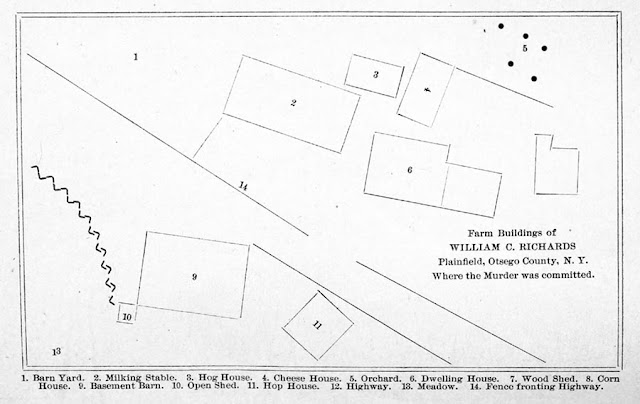“Oh my stars! Oh my Stars!” said Buel, apparently horrified.
They went to the farmhouse to notify the family. Both Mr. and Mrs. Richards were away that day, so they took Catherine’s sister Maggie and the housekeeper to the barn. Maggie asked Buel what had happened to Catherine, and he said the bull must have killed her.
Buel repeated this several times and it became the accepted story until the coroner got a look at the body. He concluded that Catherine had not been gored by the bull, someone had strangled her and hit her in the face with a blunt object. He also found evidence that she had been raped.
Myron Buel became the prime suspect in Catherine’s murder. Buel was called “The Boy Murderer” but he was 20 years old in 1878. He was madly in love with Catherine, though she was six years younger. He had asked her to marry him, and when she refused, Buel made improper suggestions, driving her to tears. Though he always recanted later, he continued making lewd comments until Catherine threatened to tell her parents.
On the day of the murder, when Buel and Bowen were working in the hops field, he told Bowen that the rubber boots he was wearing were too hot and he went back to the house to change them. He was gone for about 45 minutes. When Bowen asked what took him so long, he said he had to put away a horse that had gotten loose.
Buel was charged with murder and brought to trial on February 17, 1879. The trial lasted ten days and the courtroom was crowded with spectators each day. Following the closing arguments, the judge spoke for an hour and a half, giving instructions to the jury. The jury deliberated for four hours before returning a verdict of guilty.
Buel’s lawyers moved for a new trial on the grounds that the judge had instructed the jury to find him guilty of first-degree murder or acquit him. He should have instructed them on the several degrees of manslaughter as well. The motion was denied, and the judge sentenced Myron Buel to be hanged on April 18.
The execution date was changed to November 14 to allow Buel’s attorneys to argue before the Court of Appeals. The Court refused to grant a new trial and affirmed the judgement of the lower court. They petitioned the Governor for a reprieve, but he refused.
Throughout the process, Buel maintained his innocence but, three days before his execution, with no hope left, Buel confessed to his spiritual advisors and his counsel. In his confession, Buel said he was angry because Catherine had told her parents about his “passionate desire” for her. On the day of the murder, he knew Mr. and Mrs. Richards would not be home. When he told Bowen he was going to change his boots, he was going to kill Catherine.
“Oh! How I felt as I went down the path to the barn!” Buel confessed.
He found Catherine in the cheese house, playing with her kittens. He had let out the calf, knowing she would help him bring it back to the barn. When they were inside the barn, he shut the door and quickly threw a rope around her neck and pulled it tight.
“Her eyes looked terrible when she was struggling,” said Buel, “Then I struck her with a milking stool that stood by me. I then ravished her. She was dead but warm when I committed the crime.”
He carried her to the bull’s stall so it would appear that the bull killed her, then he let the bull out.
“I loved Catherine and was jealous. I intended to kill her and ravish her because I was mad.”
Myron Buel was hanged on November 14, 1879. The gallows in New York State at the time used a counterweight to jerk the condemned man upward. At 10:39 a.m. the body shot four feet up in the air and fell back with a sickening thud. Fourteen minutes later Drs. Westlake and Hills pronounced him dead.
Sources:
“Buel Confesses,” WEEKLY FREEMAN, November 14, 1879.
“The Gallows,” Daily Gazette, April 19, 1879.
Gordon W. Treadwell, Myron Buel the Boy Murderer (Birmingham: Republican Print, 1879.)
“Hanging of Myron A. Buell,” Chicago Tribune, November 15, 1879.
“The Murder of Miss Richards,” New York Times, June 29, 1878.
“Myron A. Buell,” The Brooklyn Daily Egal, November 15, 1879.
“Probable Murder,” New York herald., June 28, 1878.
“A Ravisher Held for Murder,” Fall River Daily Herald, July 3, 1878.
“To be Hanged,” New York Herald, March 1, 1879.









.jpg)











0 comments :
Post a Comment